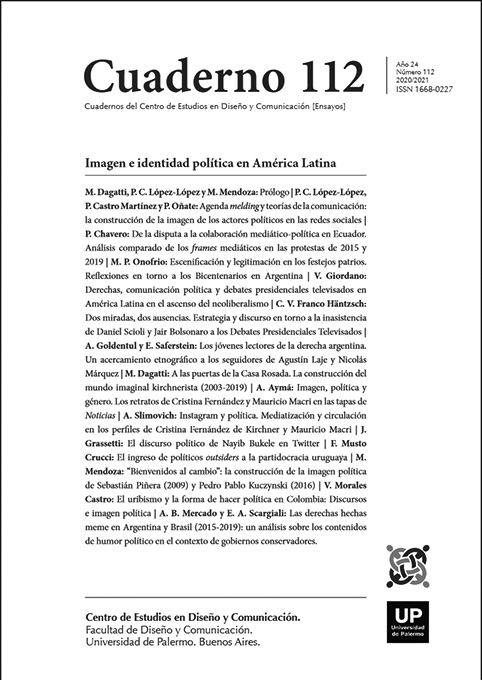De la disputa a la colaboración mediático-política en Ecuador. Análisis comparado de los frames mediáticos en las protestas de 2015 y 2019
Abstract
The last decade in Ecuador was marked by the media-political dispute between the former President of the Republic, Rafael Correa, and the private media that became political actors. With the arrival in 2017 of the new president Lenín Moreno (a successor of Correa himself), Ecuador faced a change not only of leader, but also a sharp turn in national politics. The conservative political and economic forces, adversaries during Correa's presidency, became Moreno allies. In this context, the mass media also turned from being adversaries and contesting Correa’s political field to become Moreno’s allies. This article presents a comparative analysis of the way in which two of the main media framed the social reactions to different economic measures: the inheritance and capital gains laws of Correa (2015) and the Decree 883 of Moreno (2019). It involves the analyze of two newspapers, El Telégrafo (public) and El Comercio (private), since they allow to identify the differences between the media based on their legal nature in each period.
References
Albuquerque, A. (2012). “O Paralelismo político em questão”. Revista COM Política 2 (1).
Chavero, P. (2015). Prensa y política en tiempos de crisis: estudio de la legislatura 2008-2011. Madrid: CIS.
Chavero, P. (2015b). “Intervención del Estado en Comunicación: políticas públicas para la democratización de la comunicación. Una aproximación al caso de Ecuador”. ALCANCE, Revista cubana de información y comunicación 4 (8), pp. 3-25.
Chavero, P. y Oller, M. (2015). “Políticas públicas en comunicación y sistemas mediáticos. El caso de Ecuador”. La Comunicación y el Periodismo de Ecuador frente a los desafíos contemporáneos. Cuadernos Artesanos de Comunicación Nº 74. La Laguna.
Chavero, P. (2018). “Mediatización de la política en los nuevos gobiernos latinoamericanos: de la confrontación a la reconciliación”. Revista Internacional de Comunicación y Desarrollo Nº 8, pp. 119-128.
Entman, R. (1993). “Framing: toward clarification of a fractured paradigm”. Journal of Communication 43 (4), 51-58.
Entman, R. (2004). Projections of power. Framing news, public opinion and US foreign policy. Chicago & London: The University Chicago Press.
Fiss, O. (1997). Libertad de expresión y estructura social. México: Distribuciones Fontamara.
Guerrero, M y Márquez, M. (2014). “El modelo “liberal capturado” de sistemas mediáticos, periodismo y comunicación en América Latina”. Temas de Comunicación. Nº 29, pp. 135-170.
Hallin, D. y Mancini, P. (2008). Sistemas mediáticos comparados. Barcelona: Hacer Editorial.
Hallin, D. y Papathanassopoulos, S. (2002). “Political clientelism and the media: southern Europe and Latin America in comparative perspective”. Media, Culture and society 24 (2), pp: 175-195.
Mazzoleni, G. y Schulz, W. (1999). “Mediatization of politics: a challenge for democracy?”. Political Communication 16, pp: 247-261.
McCombs, M. (2004). Estableciendo la agenda. Barcelona: Paidós Comunicación.
Meyer, T. (2002). Media democracy: how the media colonize politics. Cambridge: Polity Press.
Strömback, J. (2008). “Four Phases of Mediatization: An Analysis of the Mediatization of Politics”. Press/Politics 13 (3), pp: 228-246.
Los autores/as que publiquen en esta revista ceden los derechos de autor y de publicación a "Cuadernos del Centro de Estudios de Diseño y Comunicación", Aceptando el registro de su trabajo bajo una licencia de atribución de Creative Commons, que permite a terceros utilizar lo publicado siempre que de el crédito pertinente a los autores y a esta revista.


